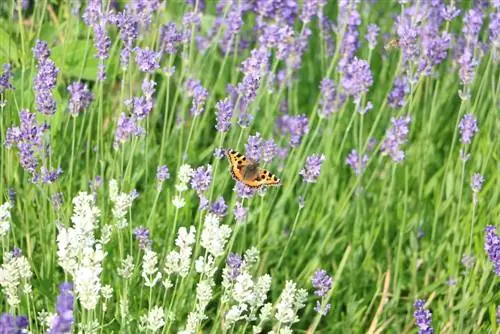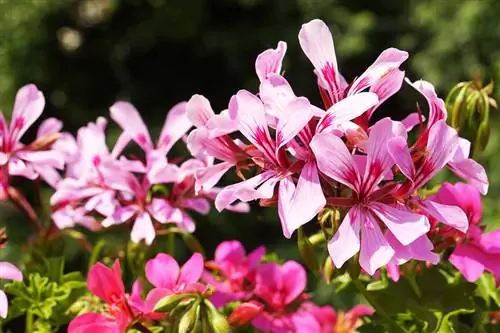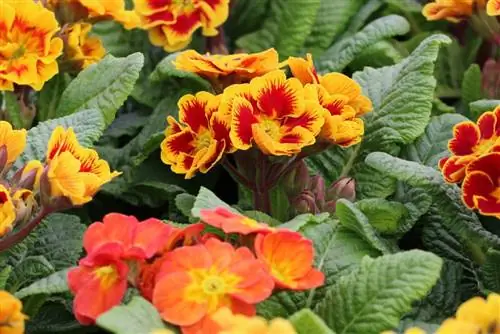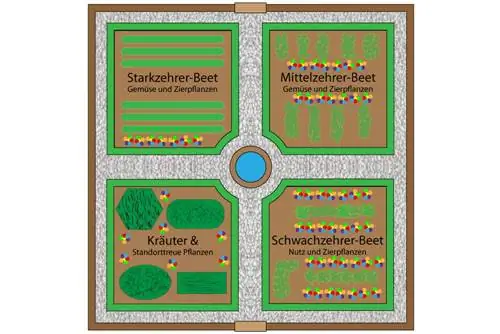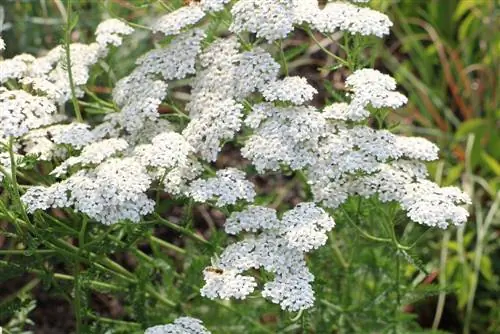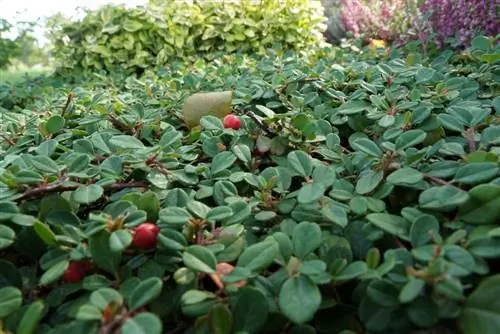- Author admin [email protected].
- Public 2023-12-17 03:39.
- Last modified 2025-06-01 06:48.
A garden is only complete when the diverse shapes and colors of the plants are accompanied by tempting scents. The fresh, lively scent of a flower or a leaf has a positive effect on our well-being and cannot be compared with anything. The scent of lavender brings back memories of your last vacation in France and blue world champion, lilac and tuberose create romantic images in your head. Many of the fragrant companions can be cleverly arranged with each other and with other plants.
Scented plants for the home
Gardenia - Gardenia jasminoides
- comes from China
- jasmine-like scent
Wreath sling - Stephanotis floribunda
- Climbing plant from Madagascar
- impresses with its captivating scent and snow-white flowers
Scented jasmine - Jasminum polyanthum
- also called pipe bush or false jasmine
- intensively fragrant flowers in the evening hours
Types of orchids
- smell at different times of the day depending on the species
- Fragrance notes range from sweet to lemony to musty (Stanhopea)
- Scented orchids include: Phalaenopsis violacea, Cattleya aclandiae, Maxillaria picta or Aerangis mooreana
Hyancinth - Hyacinthus orientalis
- smell differently sweet depending on the type
- slightly scented: 'White Pearl', 'Pink Pearl' and 'Blue Pearl'
- subtle scent: pink 'Splendid Cornelia' and 'Anna Marie'
- intense smelling: 'Delft Blue' and 'Blue Star'
Tuberose - Polianthes tuberosa
- smells intensely sweet in the evening hours
- A common ingredient in perfume production due to its captivating scent
Orange tree - Citrus sinensis
- pleasantly scented citrus plant
- blooming
- provides tiny sour fruits in summer
Sweet scented flower - Osmanthus fragrans
- smells intensely and sweetly of peach blossoms
- ideal for winter gardens
- numerous flowers in different colors: from pale orange to bright yellow to the golden tone of apricot
Winged Candle Bush - Cassia didymobotrya
- also called spice bark or peanut cassia
- intense peanut scent
- impresses with vertically growing, candle-like inflorescences
Indoor cypresses - Cupressus macrocarpa
- very unique scent of lemon
- robust houseplant that forgives care mistakes
Silver Acacia - Acacia dealbata
- also known as yellow mimosa
- Flowers spread a characteristic delicate scent of violets
- shines in white, yellow or orange tones in the winter season
Myrtle - Myrtus communis
- The small, distinctive flowers and the dark, shiny leaves exude an unmistakable scent
- used to be a fertility symbol, later popular bridal jewelry
Scented Pelargoniums
- depending on the type, particularly intense, aromatic or nutty scents (cedar, lemon, apple, carrot, eucalyptus, rose, camphor, mint)
- countless spectrum of colors and shapes of flowers
Tip:
The flowering of houseplants can be extended if they are placed in cooler locations and the soil is always kept moist.
Scented plants for the garden
Blue World Champion - Asperula azurea
- annual plant with sky blue flowers
- blooms from June to September
- exudes sweet, pleasant floral scent
Ornamental tobacco - Nicotiana sanderae
- trumpet-shaped flowers open in the evening and exude a wonderful scent
- Color variety of flowers ranges from white to pink to red
- Flowering period June to September
Miracle flower - Mirabilis jalapa
- smells pleasantly like oranges
- shows up in different flower colors (white, yellow, crimson)
- Continuous bloomers from June to October
- Evening bloomers
Farmer’s Tobacco - Nicotiana alata
- also known as winged tobacco and violet tobacco
- exudes a captivating and heavy sweet scent from evening to morning
- impresses with green-yellowish flowers until the first frosty nights
Gingerbread tree (Cercidiphyllum japonicum)
- fascinating plant that emits its intense scent more strongly in damp weather
- when the leaves dry up, the scent disappears, which is reminiscent of freshly baked cake
- deciduous small tree with chimney-red flowers in April and yellow-orange autumn color
Scented vetch - Lathyrus odoratus
- annual climbing plant with colorful butterfly flowers
- smells intensely and lightly of orange
Angel Trumpet - Datura
- Solanaceae
- trumpet-shaped leaves spread an intoxicating scent
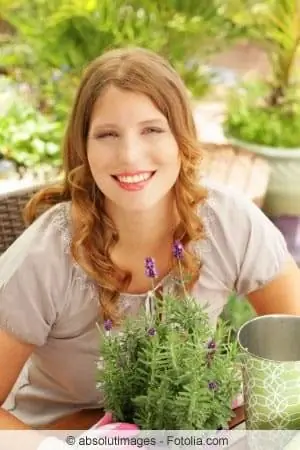
Heliotrope - Heliotropium arborescens
- also called vanilla plant and solstice
- violet to lavender-blue flowers exude an intense, characteristic scent
Lavender - Lavandula
- variant scented plant
- intense floral and balsamic scent
Magnolias - Magnolia
- inspire with a we alth of shapes and colors
- white, red or pink flowers exude a pleasant, sweet scent
- many species
Thyme - Thymus vulgaris
- Medicinal plant with a wide range of uses
- small, delicate pink flowers appear in summer
- Flowers and leaves exude a spicy scent
Curry herb - Helichrysum italicum
- also known as Italian Strawflower
- Leaves and flowers exude a tasty curry aroma with a note of sage
- evergreen shrub whose yellow to dark yellow flower heads appear from June to August
Lilac - Syringa
- perennial fragrant summer bloomer
- enchanting, almost beguiling, lovely scent
- scores with white or purple flowers that bloom from May to June
Snow Forsythia - Abeliophyllum distichum
- Spring bloomers with delicate white to delicate pink flowers
- smells pleasantly of almonds
- develops small, round nuts in summer
Gold lacquer - Erysimum cheiri
- golden yellow petals exude an aromatic, sweet scent
- different multicolored varieties
- Spring bloomers
Wisteria - Wisteria
- also known as wisteria or Chinaflor
- decorative shrub with long-stemmed leaves and white, blue or pink flower clusters
- exudes a charming spicy-sweet scent in the evening hours
Magic hazel - witch hazel
- fascinating winter bloomer
- presents itself with thread-like, bright yellow to red petals
- exudes sweet scent of honey
Rockrose - Cistus
- aromatically scented shrub
- floriferous
Flameflower - Phlox
- more or less strongly scented depending on the variety
- Color spectrum ranges from white to pink and red tones, up to dark violet
Arabian marigold - Cladanthus arabicus
- tireless summer flower
- smells intensely of ripe banana
- easy-care composite plant with bright yellow daisy-like flowers
Chocolate flower (Berlandiera lyriata)
- perennial pot plant with bright yellow inflorescence
- exudes intensely fragrant typical chocolate smell
- grows up to 30 cm high
Scented Stonewort (Lobularia maritima)
- smells like honey
- forms white or delicate pink flower carpets from April to October
- suitable as an ampel plant or in the garden
Tip: Low-growing scented plants should, if possible, be cultivated in pots, high boxes and raised beds. This makes it easier to enjoy the aromatics.
Frequently asked questions
I want to create a little oasis in a corner of my garden where I can retreat. The corner is relatively sunny. Which scented plants are suitable?
A combination of vanilla flower, ornamental tobacco and scented stone is recommended here. These plants exude a pleasant, sweet scent that has a relaxing effect.
Are there scented plants that can be kept in the bathroom?
You don't have to do without fragrant plants in the bathroom either. A plant like the Gardenia is happy when it is allowed to grow in a room with lots of light and high humidity.
What you should know about fragrant flowers in brief
Fragrant spring flowers
Flower bulbs and tubers produce their leaves, flowers and seeds in a very short time in spring. They usher in spring and enrich garden and park landscapes with their splendor of color. The best-known and most popular early bloomers include the bleeding heart, grape hyacinth, crocuses, snowdrops, March cups, Christmas roses, daffodils, tulips, anemones, pansies, horned violets and chimney sweeps. Bulb and tuberous flowers look best when planted in groups. They are suitable for planting beds and borders. Crocuses and snowdrops also work very well on lawns. Spring bloomers are planted in the ground in late summer. Insensitive species can also be planted in October.
Fragrant ornamental trees, shrubs and trees
It's not just early bloomers and summer flowers that have lush and fragrant flowers. Ornamental shrubs and trees also produce numerous flowers and fruit decorations, which provide a dominant focal point in the garden landscape. The popular hedge bushes include the flowering firethorn hedge, the spar hedge, the arborvitae hedge and the hedge barberry. They provide a framework for the garden and are particularly effective when mixed with other spring and summer flowers. Rhododendrons, fire maple, butterfly bush, magnolia, rose deutzia and farmer's hydrangea ensure particularly pronounced flowering. Ornamental trees are ideally planted in autumn.
Fragrant summer flowers and perennials
The wonderful blooming of summer flowers and perennials occurs throughout the summer. Colorful beds and borders as well as wildflower areas give the garden a harmonious expression when growth heights and colors are carefully coordinated. Delphiniums, lavender, daisies, foxgloves, wildflowers, carnations, poppies, weigela and phlox are perennial perennials that provide a colorful contrast to green lawns. Hollyhocks are a real eye-catcher and are particularly suitable for planting on walls, fences and facades. The picturesque flower stalks and pompous blooms of hollyhocks add style and charm to the garden setting. The mallows thrive in sunny locations. They bloom in countless colors, from white to champagne, pink, red to black-red.
Planting and care tips
All summer flowers, perennials, ornamental trees and trees have different care requirements. For lush blooms and he althy growth, it is important to follow the appropriate care instructions. When purchasing plants, you should pay attention to quality. The selection of locations and the right soil are just as important as an adequate supply of water and nutrients. Diseased or wilted plant parts are removed immediately to extend the flowering period. The correct planting time and depth are also important prerequisites for the flourishing of summer flowers, perennials, shrubs and trees.

